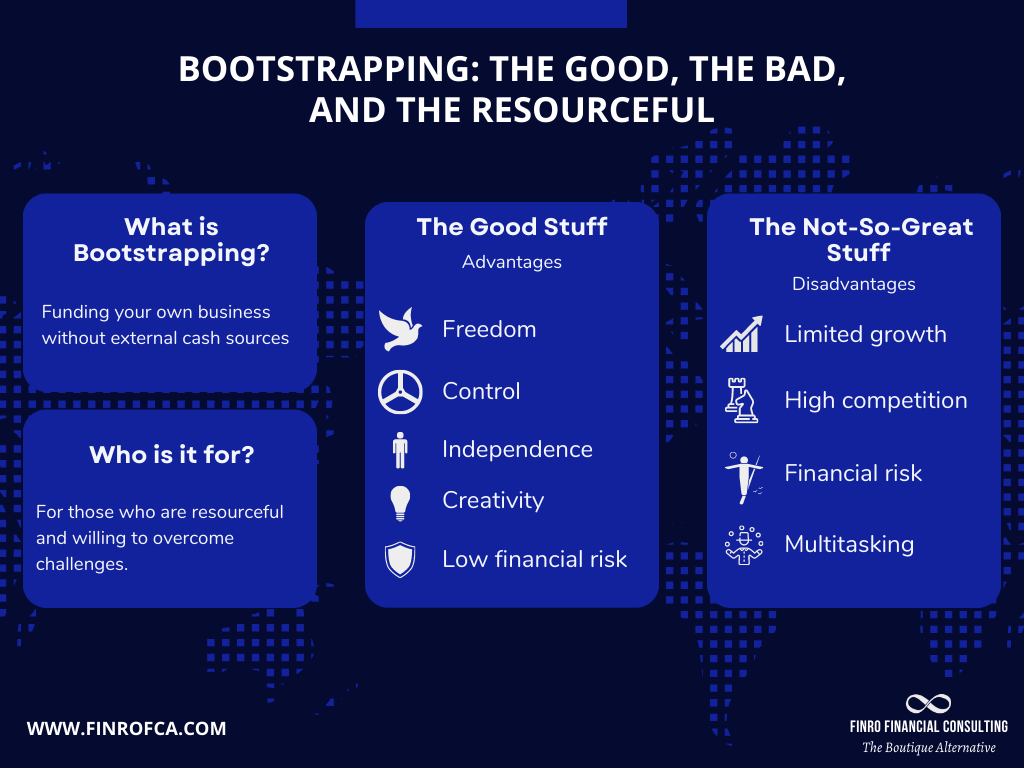The Pros and Cons of Bootstrapping vs. Startup Funding
By Lior Ronen | Founder, Finro Financial Consulting
When starting a business, you're faced with a big choice: Do you fund it yourself using your savings and the money your business makes (this is called "bootstrapping"), or do you get the money from other people or organizations, like venture capitalists, angel investors, or banks?
There's no easy answer.
Both paths have their ups and downs. Your decision will depend on things like how big your market is, how tough your competition is, how much money you need, and what you want to achieve with your business.
This article will help you figure it out.
We'll look at the good and bad sides of both bootstrapping and getting funding, and give you some tips on what to consider when deciding. So, ready to dive into the world of funding your startup?
What is Bootstrapping?
Bootstrapping is when you start your business using your own money, or the money the business makes, without getting cash from outside sources.
Basically, it's like doing a DIY job on your business' finances.
To pull it off, you might need to keep costs low, spread the word about your business through friends and social media, and come up with clever ways to make your cash stretch further.
The goal is to create a business that can grow and make more money all on its own, without needing to borrow cash from elsewhere.
The Good Stuff About Bootstrapping
When you bootstrap, you're the boss.
You get to call the shots without having to keep investors or banks happy.
This lets you focus on what's best for your business and your customers.
Plus, with some good planning and a lot of hard work, you can build a strong, stable business from scratch.
This can give your business a solid foundation and can help it withstand tough times, since it doesn't depend on money from outside sources.
One of the great things about bootstrapping is that it pushes you to be creative and resourceful when it comes to growing your business.
This can give you a leg up on your competitors.
Also, bootstrapping can be less risky for your business' finances, as you don't have to worry about paying back loans or losing part of your company to investors.
The Not-So-Great Stuff About Bootstrapping
Bootstrapping isn't all sunshine and roses.
Using your own cash to start the business can limit how much you can spend on growing and expanding, like hiring more staff or boosting production.
Since you've got a smaller budget, your business might grow slower than if you had outside funding.
This can make it harder to compete with other companies in your industry that have more money to play with.
If your business hits a snag and needs a big cash injection, bootstrapped businesses can struggle to find the money they need. If the business isn't making enough to cover costs, you could end up dipping into your savings or even landing in debt.
That's a big financial risk to take.
With bootstrapping, you'll probably need to run a tight ship, which can mean doing jobs you're not an expert in, like accounting or marketing.
If you want to grow your business fast or need a lot of cash to get started, bootstrapping might not be for you.
But if you're okay with working with what you've got and overcoming a few challenges, bootstrapping could be a great way to build a successful business.
What is Startup Funding?
Startup funding is all about finding the cash to get your new business off the ground.
This cash can come from a bunch of places like angel investors, venture capitalists, crowdfunding, or loans from banks.
The goal of startup funding is to give your new business the resources it needs to reach its goals.
This could be anything from expanding your operations, making a new product or service, or hiring more staff.
The amount of money a startup gets can really vary. It depends on things like how developed the startup is, how big the potential market is, and how willing investors are to take a risk.
There are two main types of funding a startup can get: equity and debt.
What's Equity Funding?
Equity funding is when you sell shares of your business to investors to get the cash you need.
The investors get rights to a portion of the business's profits, and they get a say in how the business is run.
Equity funding can be good for startups because you don't have to pay back the money you get, and it doesn't put too much strain on your cash flow.
The downside is you have to share control of your business, and you might have to give up some ownership.
What's Debt Funding?
Debt funding is when you borrow money from lenders like banks or individuals. Unlike equity funding, you have to pay back the money you borrow with interest.
Debt funding can be good for businesses that need cash fast, because it doesn't affect who owns or controls the business.
But if you can't pay back the loan, it can harm your business's credit rating.
The Good Stuff About Startup Funding
Funding gives you the cash you need to grow your business, hire staff, make new products, and expand.
You can make big investments in your business that you wouldn't be able to do if you were bootstrapping.
A lot of investors also bring their own experience and knowledge that can help your business grow and develop.
They might be able to help you network and connect with potential partners, customers, or other investors.
If your business manages to attract high-profile investors, it can give your business credibility, which can make it easier to attract customers, partners, and employees.
Also, having funding can reduce the risk for the entrepreneur, because you're not just relying on your personal savings or the money the business makes to keep things running.
The Not-So-Great Stuff About Startup Funding
The big downside of startup funding is you often have to give up some control of your business. Investors might make decisions that don't align with your vision for the business.
Investors also expect a return on their investment, so startups that get funding can feel pressure to meet growth targets. This pressure can lead to decisions focused more on short-term growth rather than the long-term sustainability of the business.
Raising funds can also be a real time-suck and distract from running the business. You might spend months or even years pitching to investors, negotiating terms, and doing due diligence.
And remember, just because you get funding, it doesn't guarantee your business will be a success. Startups can fail for a whole bunch of reasons, even with the backing of top-notch investors.
So, while funding can give you access to capital, expertise, and networking opportunities, it's really important to think about the potential downsides, like losing control, high costs, and the pressure to perform.
| Bootstrapping | Debt Funding | Equity Funding | |
|---|---|---|---|
| Control | Full control of the business | Full control of the business | Might lose some control due to investor influence |
| Funding Source | Self or revenue generated by the company | Loans from banks or other institutions | Investments from venture capitalists or angel investors |
| Cash Flow Impact | No additional debt burden, but possible strain on personal finances or revenues | Regular repayments with interest could impact cash flow | No immediate impact on cash flow |
| Ownership | 100% ownership | 100% ownership | Might have to give up some ownership |
| Risk | High personal financial risk if business fails | Risk of damage to credit and potential collateral loss if unable to repay | Dilution of ownership; pressure to deliver returns |
| Growth Pace | Generally slower due to financial limitations | Depends on loan size and use of funds, but potential for faster growth | Typically faster growth due to larger cash infusion |
| External Pressure | None; the entrepreneur is free to pursue the vision as desired | Pressure to repay the loan, but no impact on business direction | Pressure to meet investor growth expectations |
| Networking Opportunities | Mostly personal networking | Bank and financial institution connections | Access to investor's network and industry contacts |
| Access to Expertise | None; entrepreneur must rely on personal skills or hire talent | Access to financial advice from lenders | Investors often bring industry knowledge and experience |
| Resources | Limited to personal resources or business revenue | Limited to the size of the loan | Potentially substantial depending on investment size |
Choosing Between Bootstrapping and Getting Outside Money
Deciding between bootstrapping and getting outside money? Think about how much cash you've got.
If you've got a fat savings account or don't mind skipping a paycheck for a while, bootstrapping might work for you.
But if you're short on personal funds, you might need to get some money from outside sources.
Also, think about who you want calling the shots. If you want to keep control, bootstrapping lets you stay in the driver's seat. But remember, if you go the outside money route, you might have to share the steering wheel.
Outside funding can give you the boost you need to grow quickly, but bootstrapping might mean you'll grow more slowly due to cash constraints.
Think about your industry's competitive landscape. If it takes a big pile of money to enter your industry or if it's super competitive, you might need outside money to make your mark.
Also, consider your end game for the business. Do you dream of selling it or going public someday? Outside funding might be necessary to reach those heights. But if you're more about running your own show and maintaining control, bootstrapping might be the way to go.
Remember, there's no one-size-fits-all answer. The decision between bootstrapping and outside funding will depend on your business and your personal circumstances. The key is to weigh all these factors and make the best decision for you and your business.
Summary
Deciding between bootstrapping and outside funding is a pretty big deal for anyone starting a business. Each choice comes with its own set of perks and drawbacks, and the best option really depends on what's unique to you and your business.
Our handy comparison table gives a quick snapshot of what you might want to think about before making a choice.
It's about looking at the good and bad sides of each option and figuring out which lines up best with what you want for your business.
In the end, it's all about taking a good, hard look at the money you've got, how much control you want, your growth ambitions, what your competition is like, and where you see your business in the future.
Consider all of these things, have another look at that table, and you'll be in a good position to make the best decision for your business.






























